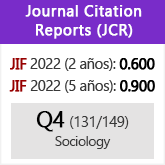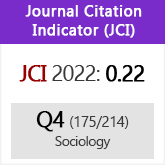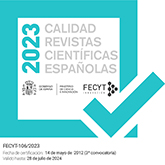La interferencia entre el estatus familiar y las características individuales en el nacimiento del primer hijo tras la emigración a España
DOI:
https://doi.org/10.3989/ris.2013.10.14Palabras clave:
Características personales, Inmigración, Fecundidad, Situación familiar, InterferenciaResumen
El objetivo del trabajo es analizar los factores que afectan el nacimiento del primer hijo tras la migración. En particular, nos centramos en las condiciones familiares y en las características sociodemográficas de las mujeres migrantes a la llegada a España. La hipótesis general es que el comportamiento reproductivo después de migrar está íntimamente relacionado con la situación a la llegada. A la vez, consideramos que las diferentes situaciones familiares interactúan con las características individuales generando distintos efectos en la probabilidad de tener el primer hijo. En el análisis se han estimado modelos de supervivencia en tiempo discreto a los datos de la Encuesta Nacional de Inmigrantes de 2007. Los resultados muestran, en primer lugar, la importancia en la fecundidad del estado civil y el número de hijos previos tras la migración, aunque se observan ciertas interferencias entre la situación familiar y las características personales del migrante.
Descargas
Citas
Abbasi-Shavazi, M. y P. McDonald. 2000. «Fertility and Multiculturalism: Immigrant Fertility in Australia, 1977-1991». International Migration Review 34:215-242. http://dx.doi.org/10.2307/2676018
Abbasi-Shavazi, M. y P. McDonald. 2002. «A comparison of fertility patterns of European immigrants in Australia with those in the countries of origin». Genus 58:53-76.
Alders, M. 2000. «Cohort fertility of migrant women in the Netherlands: Developments in fertility of women born in Turkey, Morocco, Suriname, and the Netherlands Antilles and Aruba», paper presented at the BSPS-NVD-URU Conference on New Paths in Exploring and Analysing Demographic Data, Utrecht. PMCid:PMC1378011
Andersson, G. 2004. «Childbearing after migration: Fertility patterns of foreignborn women in Sweden». International Migration Review 38:747-774. http://dx.doi.org/10.1111/j.1747-7379.2004.tb00216.x
Baizán, P., A. Aassve y F. Billari. 2003. «Cohabitation, Marriage, and First Birth: The Interrelationship of Family Formation Events in Spain». European Journal of Population 19:147-169. http://dx.doi.org/10.1023/A:1023343001627
Bledsoe, C. H., R. Houle y P. Sow. 2007. «High fertility Gambians in low fertility Spain: The dynamics of child accumulation cross transnational space». Demographic Research 16:375-411. http://dx.doi.org/10.4054/DemRes.2007.16.12
Blossfeld, H.-P. y U. Jaeninchen. 1992. «Educational expansion and changes in women's entry into marriage and motherhood in the Federal Republic of Germany». Journal of Marriage and the Family 54:302-315. http://dx.doi.org/10.2307/353062
Bonngarts, J. 2003. «Completing the fertility transition in the developing world: The role of educational differences and fertility preferences». Population Studies 57:321-335. http://dx.doi.org/10.1080/0032472032000137835 PMid:14602532
Carter, M. 2000. «Fertility of Mexican immigrant women in the U.S: A closer look». Social Science Quarterly 81:1073-1086.
Castro-Martín, T. y L. Rosero-Bixbi. 2011. «Maternidad y fronteras. La fecundidad de las mujeres inmigrantes en Espa-a». Revista Internacional de Sociología 69:105-137. http://dx.doi.org/10.3989/ris.2011.iM1.388
Castro-Martín, T., M. Domínguez-Folgueras y T. Martín-García. 2008. «Not truly partnerless: Non-residential partnerships and retreat from marriage in Spain». Demographic Research 18:443-468. http://dx.doi.org/10.4054/DemRes.2008.18.16
Cerrutti, M. y D. S. Massey. 2001. «On the Auspices of Female Migration from Mexico to the United States». Demography 38:187-200. http://dx.doi.org/10.1353/dem.2001.0013 PMid:11392907
Coleman, D. A. 1994. «Trends in fertility and intermarriage among immigrant populations in Western Europe as measure of integration». Journal of Biosocial Science 26:107-136. http://dx.doi.org/10.1017/S0021932000021106 PMid:8200876
Cortina Trilla, C., X. Bueno García y T. Castro Martín. 2010. «¿Modelos familiares de aquí o de allá? Cohabitación y fecundidad fuera del matrimonio entre los latinoamericanos en Espa-a». América Latina Hoy 55:61-84.
Curran, S. R. y A. C. Saguy. 2001. «Migration and Cultural Change: A Role for Gender and Social Networks». Journal of International Women's Studies 2:54-77.
Curran, S. R. y E. Rivero-Fuentes. 2003. «Engendering migrant networks: the case of Mexican migration». Demography 40:289-307. http://dx.doi.org/10.1353/dem.2003.0011 PMid:12846133
DeJong, F. D., B. D. Root y R. G. Abad. 1986. «Family Reunification and Philippine Migration to the United States: The Immigrants' Perspective». International Migration Review 20:598-611. http://dx.doi.org/10.2307/2545706 PMid:12268140
Domínguez-Folgueras, M. y T. Castro-Martín. 2008. «Women's changing socioeconomic position and union formation in Spain and Portugal». Demographic Research 19:1513-1550. http://dx.doi.org/10.4054/DemRes.2008.19.41
Feliciano, C. 2005. «Educational selectivity in U.S. immigration». Demography 42:131-152. http://dx.doi.org/10.1353/dem.2005.0001 PMid:15782899
Ford, K. 1990. «Duration of Residence in the United States and the Fertility of U.S. Immigrants». International Migration Review 24:34-68. http://dx.doi.org/10.2307/2546671 PMid:12316218
Frejka, T. y J.-P. Sardon. 2007. «Cohort birth order, parity progression ratio and parity distribution trends in developed countries». Demographic Research 16:315-374. http://dx.doi.org/10.4054/DemRes.2007.16.11
Goldstein, S. 1973. «Interrelations Between Migration and Fertility in Thailand». Demography 10:225-241. http://dx.doi.org/10.2307/2060815 http://dx.doi.org/10.2307/2060815
Hoem, J. M. 1986. «The impact of education on modern family-union initiation». European Journal of Population 2:113-133. http://dx.doi.org/10.1007/BF01796886
Instituto Nacional de Estadística (INE). 2007. «Metodología General». Pp. 12-13 en Encuesta Nacional de Inmigrantes 2007. Consultado en Marzo de 2013 (www.ine.es/ fenómenos demográficos/Encuesta Nacional de Inmigrantes 2007).
Kahn, J. R. 1988. «Immigrant Selectivity and Fertility Adaptation in the United States». Social Forces 67:108-128. http://dx.doi.org/10.1093/sf/67.1.108
Kahn, J. R. 1994. «Immigrant and Native Fertility during the 1980s: Adaptation and Expectations for the Future». International Migration Review 28:501-519. http://dx.doi.org/10.2307/2546818 PMid:12345792
Kiernan, K. 1999. «Chilbering outside marriage in Western Europe». Population Trends 98:11-20. PMid:10658241
Kofman, E. 1999. «Female 'Birds of Passage' a Decade Later: Gender and Immigration in the European Union». International Migration Review 33:269-299. http://dx.doi.org/10.2307/2547698 PMid:12319733
Kulu, H. 2005. «Migration and fertility: Competing hypotheses re-examined». European Journal of Population 21:51-87. http://dx.doi.org/10.1007/s10680-005-3581-8
Lindstrom, D. P. y S. Giorguli. 2007. «The interrelationship between fertility, family maintenance, and Mexico-U.S. migration». Demographic Research 17:821-858. http://dx.doi.org/10.4054/DemRes.2007.17.28
Massey, D. S. 1990. «Social Structure, Household Strategies, and the Cumulative Causation of Migration». Population Index 56:3-26. http://dx.doi.org/10.2307/3644186 PMid:12316385
Massey, D. S., R. Alarcon, J. Durand y H. Gonzalez. 1987. Return to Azatlán: The Social Process of International Migration from Western Mexico. Berkeley: University of California.
Milewski, N. 2007. «First child of immigrant workers and their descendants in West Germany: Interrelation of events, disruption, or adaptation?». Demographic Research 17:859-896. http://dx.doi.org/10.4054/DemRes.2007.17.29
Mulder, C. H. y M. Wagner. 1993. «Migration and marriage in the life course: A method for studying synchronized events». European Journal of Population 9:55-76. http://dx.doi.org/10.1007/BF01267901 PMid:12344903
Mussino, E. y S. Strozza. 2012. «The fertility of immigrants after arrival: The Italian case». Demographic Research 26:99-130. http://dx.doi.org/10.4054/DemRes.2012.26.4
Myrskyla, M., H.-P. Kohler y F. C. Billari. 2009. «Advances in development reverse fertility declines». Nature 460:441-443. http://dx.doi.org/10.1038/nature08230 PMid:19661915
Parrado, E. A. y C.A. Flippen. 2005. «Migration and Gender among Mexican women». American Sociological Review 70:606-632. http://dx.doi.org/10.1177/000312240507000404
Parrado, E. A. y S. P. Morgan. 2008. «Intergenerational fertility among Hispanic women: new evidence of immigrant assimilation». Demography 45:651-71. http://dx.doi.org/10.1353/dem.0.0023 PMid:18939666 PMCid:PMC2782440
Parrado, E. A. 2011. «How High is Hispanic/Mexican Fertility in the U.S.? Immigration and Tempo Considerations». Demography 48:1059-1080. http://dx.doi.org/10.1007/s13524-011-0045-0 PMid:21695573
Population Reference Bureau. 2007. 2007 World Population Data Sheet. Washington, D. C.: PRB.
Reher, D. y M. Requena. 2009. «The National Immigrant Survey of Spain. A new data source for migration studies in Europe». Demographic Research 20:253-278. http://dx.doi.org/10.4054/DemRes.2009.20.12
Reher D-S. y M. Requena. 2009. Las múltiples caras de la inmigración en Espa-a. Madrid: Alianza Editorial. PMCid:PMC2812977
Reher, D., M. Requena y M. Sánchez-Domínguez. 2013. «How level is the Playing Field? Divided Families Among Latin American Immigrants in Spain». The History of the Family 18:26-43. http://dx.doi.org/10.1080/1081602X.2012.755931
Requena, M. y M. Sánchez-Domínguez. 2011. «Las familias inmigrantes en Espa-a». Revista Internacional de Sociología 69:79-104. http://dx.doi.org/10.3989/ris.2011.iM1.387
(Del) Rey, A. y D. Vono. 2014. «Marrying after arriving: the role of individuals' networks for immigrant choice of partner's origin». Advances in Life Course Research 19:28-39. http://dx.doi.org/10.1016/j.alcr.2013.10.003 PMid:24796876
(Del) Rey, A. y M. Cebrián. 2010. «Population Replacement and Migration in Two Spanish Regions during the Twentieth century». Population 65:481-498. http://dx.doi.org/10.3917/pope.1003.0481
Rindfuss, R. R., S. P. Morgan y G. Swicegood. 1988. First Birth in America: Change in the Timing of Parenthood. Berkeley: University of California Press.
Roig-Vila, M. y T. Castro-Martín. 2007. «Childbearing patterns of foreign women in a new immigration country: the case of Spain». Population-E 62:351-380. http://dx.doi.org/10.3917/pope.703.0351
Sánchez-Domínguez, M., H. de Valk y D. Reher. 2011. «Marriage strategies among immigrants in Spain». Revista Internacional de Sociología 69:139-166. http://dx.doi.org/10.3989/ris.2011.iM1.389
Sobotka, T. 2008. «The rising importance of migrants for childbearing in Europe». Demographic Research 19:225-248. http://dx.doi.org/10.4054/DemRes.2008.19.9
Stanek, M. 2009. «Patterns of Romanian and Bulgarian migration to Spain». Europe Asia Studies 61:1627-1644. http://dx.doi.org/10.1080/09668130903209160
Stephen, E. H. y E D. Bean. 1992. «Assimilation, Disruption and the Fertility of Mexican-Origin Women in the United States». International Migration Review 6:67-88. http://dx.doi.org/10.2307/2546937
Toulemon, L. 2004. «Fertility among immigrant women: new data, a new approach». Population and Societies 400:1-4.
Publicado
Cómo citar
Número
Sección
Licencia
Derechos de autor 2015 Consejo Superior de Investigaciones Científicas (CSIC)

Esta obra está bajo una licencia internacional Creative Commons Atribución 4.0.
© CSIC. Los originales publicados en las ediciones impresa y electrónica de esta Revista son propiedad del Consejo Superior de Investigaciones Científicas, siendo necesario citar la procedencia en cualquier reproducción parcial o total.Salvo indicación contraria, todos los contenidos de la edición electrónica se distribuyen bajo una licencia de uso y distribución “Creative Commons Reconocimiento 4.0 Internacional ” (CC BY 4.0). Puede consultar desde aquí la versión informativa y el texto legal de la licencia. Esta circunstancia ha de hacerse constar expresamente de esta forma cuando sea necesario.
No se autoriza el depósito en repositorios, páginas web personales o similares de cualquier otra versión distinta a la publicada por el editor.

















